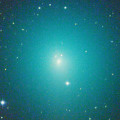
|
Now it is very bright as 6.5 mag (Mar. 28, Juan Jose Gonzalez). It approaches to Earth down to 0.14 a.u. from March to April, and brightens up to 5-6 mag. It may brighten furthermore in outburst. It is observable in excellent condition in the Northern Hemisphere. In the Southern Hemisphere, it is not be observable for about one month from late March to late April.
Date(TT) R.A. (2000) Decl. Delta r Elong. m1 Best Time(A, h)
Apr. 1 13 26.10 64 35.4 0.142 1.057 110 5.6 0:43 (180, 61)
Apr. 8 15 31.44 63 17.7 0.146 1.047 104 5.4 2:22 (180, 62)
|
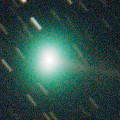
|
Bright new comet. It brightened very rapidly. Now it is very bright as 7.1 mag (Mar. 30, Marco Goiato). In the Northern Hemisphere, it stays observable in the morning sky until late April. In the Southern Hemisphere, it becomes unobservable soon.
Date(TT) R.A. (2000) Decl. Delta r Elong. m1 Best Time(A, h)
Apr. 1 21 38.21 9 50.7 0.608 0.721 45 7.1 4:21 (274, 22)
Apr. 8 22 52.57 26 6.1 0.686 0.615 37 6.6 4:10 (251, 19)
|
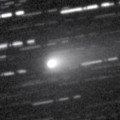
|
Now it is 8.5 mag (Mar. 30, Marco Goiato). It is expected to brighten up to 7 mag from April to May. It locates low in the Northern Hemisphere.
Date(TT) R.A. (2000) Decl. Delta r Elong. m1 Best Time(A, h)
Apr. 1 20 29.61 -16 30.7 1.235 1.226 65 7.8 4:21 (307, 18)
Apr. 8 21 4.84 -13 31.1 1.199 1.170 63 7.6 4:10 (301, 17)
|
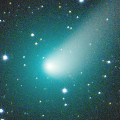
|
Now it is 9.3 mag (Mar. 29, Marco Goiato). It is expected to brighten up to 6-7 mag from April to July. In the Northern Hemisphere, it stays observable in excellent condition until June. In the Southern Hemisphere, it stays extremely low for a while.
Date(TT) R.A. (2000) Decl. Delta r Elong. m1 Best Time(A, h)
Apr. 1 16 31.28 47 35.8 1.338 1.898 107 8.4 3:54 (180, 77)
Apr. 8 16 27.53 47 31.6 1.258 1.854 109 8.2 3:23 (180, 78)
|
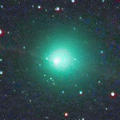
|
Now it is fading rapidly. It has already faded down to 9.6 mag (Mar. 31, Andrew Pearce). In the Southern Hemisphere, it stays observable after this while the comet will be fading. In the Northern Hemisphere, it stays unobservable until May when it becomes fainter than 14 mag.
Date(TT) R.A. (2000) Decl. Delta r Elong. m1 Best Time(A, h)
Apr. 1 22 32.48 -17 59.8 0.907 0.640 38 9.0 4:21 (288, -5)
Apr. 8 22 34.54 -18 10.3 0.995 0.769 45 10.5 4:10 (290, -2)
|
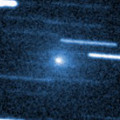
|
Bright new comet. Now it is 11.0 mag (Mar. 31, Andrew Pearce). It stays 11-12 mag until May. In the Southern Hemisphere, it stays observable for a long time, but it stays low. It will not be observable in early April in the Northern Hemisphere. Juan Jose Gonzalez reported it is very bright as 9.2 mag on Mar. 28.
Date(TT) R.A. (2000) Decl. Delta r Elong. m1 Best Time(A, h)
Apr. 1 21 56.13 -5 36.3 1.356 0.915 42 11.3 4:21 (284, 10)
Apr. 8 22 32.69 -3 60.0 1.396 0.901 40 11.3 4:10 (279, 6)
|

|
It has not been observed yet in this apparition. The condition of this apparition is worst. It will brighten up to 10 mag in spring, but not observable at all.
Date(TT) R.A. (2000) Decl. Delta r Elong. m1 Best Time(A, h)
Apr. 1 0 52.93 8 25.0 2.092 1.100 4 11.9 19:46 (111,-13)
Apr. 8 1 21.51 10 18.3 2.074 1.080 4 11.5 19:53 (113,-13)
|
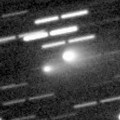
|
Now it is 11.6 mag (Mar. 31, Andrew Pearce). Bright new fragment BT was discovered on Feb. 10. Now the fragment BT is fainter than the primary component. In the Southern Hemisphere, it stays observable for a long time after this. In the Northern Hemisphere, it is not observable temporarily until mid June.
Date(TT) R.A. (2000) Decl. Delta r Elong. m1 Best Time(A, h)
Apr. 1 22 15.55 -15 51.1 1.496 0.996 41 12.3 4:21 (289, 0)
Apr. 8 22 44.57 -13 56.5 1.537 1.023 41 12.5 4:10 (286, -2)
|
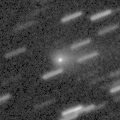
|
Now it is 16.4 mag (Mar. 8, Thomas Lehmann). It is expected to brighten up to 10 mag in summer. But actually, it is much fainter than this ephemeris recently. It will be observable in excellent condition in the Southern Hemisphere. It locates low in the Northern Hemisphere.
Date(TT) R.A. (2000) Decl. Delta r Elong. m1 Best Time(A, h)
Apr. 1 16 19.27 -15 25.0 1.024 1.798 125 13.0 3:42 ( 0, 40)
Apr. 8 16 26.45 -16 18.2 0.947 1.769 130 12.7 3:22 ( 0, 39)
|

|
Appearing in the morning sky. Now it is 15.3 mag (Mar. 5, CAO, San Pedro de Atacama).
Date(TT) R.A. (2000) Decl. Delta r Elong. m1 Best Time(A, h)
Apr. 1 21 19.86 -16 3.2 6.388 5.855 53 13.8 4:21 (297, 10)
Apr. 8 21 23.96 -15 39.8 6.294 5.853 59 13.8 4:10 (299, 12)
|
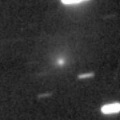
|
Now it is bright as 14.4 mag (Jan. 14, Thomas Lehmann). It is not observable now in the Northern Hemisphere. It will be unobservable temporarily in May also in the Southern Hemisphere. It will be getting higher gradually in the morning sky after summer. Then it will be observable at 11 mag for a long time from 2017 autumn to 2018 winter.
Date(TT) R.A. (2000) Decl. Delta r Elong. m1 Best Time(A, h)
Apr. 1 3 13.12 -19 28.3 5.436 4.773 44 14.5 19:46 ( 68, -2)
Apr. 8 3 18.24 -18 13.7 5.428 4.720 41 14.4 19:53 ( 73, -7)
|
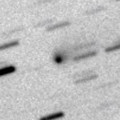
|
Now it is 15.4 mag (Feb. 25, T. Ikemura, H. Sato). It will brighten up to 14 mag from spring to summer. It locates somewhat low in the Northern Hemisphere. The perihelion distance increased from 2.4 a.u. to 2.9 a.u. in this apparition. So it will not be bright as before.
Date(TT) R.A. (2000) Decl. Delta r Elong. m1 Best Time(A, h)
Apr. 1 16 30.99 -20 1.9 2.422 3.072 122 14.6 3:54 ( 0, 35)
Apr. 8 16 31.44 -20 16.6 2.333 3.061 128 14.5 3:27 ( 0, 35)
|
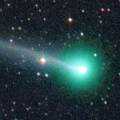
|
It approached to Earth down to 0.08 a.u. in mid February, and brightened up to 6.5 mag (Feb. 10, Danil Sidorko). Now it is fading rapidly. It has already faded down to 11.2 mag (Mar. 19, Osamu Miyazaki).
Date(TT) R.A. (2000) Decl. Delta r Elong. m1 Best Time(A, h)
Apr. 1 10 31.77 19 21.7 0.743 1.640 140 14.6 21:52 ( 0, 74)
Apr. 8 10 32.53 18 15.1 0.872 1.727 134 15.3 21:25 ( 0, 73)
|
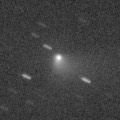
|
Small outburst occured in mid March. Now it is 13.5 mag (Mar. 15, J.P.Navarro Pina). It is observable in excellent condition in the Northern Hemisphere. It stays low in the Southern Hemisphere.
Date(TT) R.A. (2000) Decl. Delta r Elong. m1 Best Time(A, h)
Apr. 1 11 36.58 31 42.3 1.732 2.584 140 14.7 22:56 ( 0, 87)
Apr. 8 11 33.23 30 59.6 1.791 2.604 135 14.9 22:25 ( 0, 86)
|
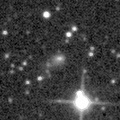
|
Now it is 15.7 mag (Mar. 7, Kunihiro Shima). It will be observable at 13 mag for a long time from 2017 to 2018.
Date(TT) R.A. (2000) Decl. Delta r Elong. m1 Best Time(A, h)
Apr. 1 19 10.52 5 32.5 4.706 4.678 82 14.9 4:21 (306, 48)
Apr. 8 19 8.72 6 53.7 4.557 4.643 88 14.8 4:10 (310, 52)
|
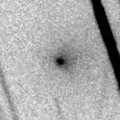
|
It brightened very rapidly, and brightened up to 10.7 mag in late February (Feb. 24, Juan Jose Gonzalez). Now it is faint as 14.7 mag (Mar. 26, Sandor Szabo). Small comet, but it approaches to Sun down to 0.9 a.u., and to Earth down to 0.5 a.u. It is observable in excellent condition in the Northern Hemisphere. In the Southern Hemisphere, it stays observable only until mid February.
Date(TT) R.A. (2000) Decl. Delta r Elong. m1 Best Time(A, h)
Apr. 1 4 35.76 70 54.6 0.528 1.010 75 14.9 19:46 (159, 44)
Apr. 8 6 52.23 77 11.4 0.533 1.069 82 16.2 19:53 (171, 46)
|
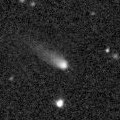
|
Now it is 15.6 mag (Feb. 15, Alexander Baransky). It will brighten up to 12-13 mag and will be observable in good condition in summer. Now it is not observable. It will appear in the morning sky in May.
Date(TT) R.A. (2000) Decl. Delta r Elong. m1 Best Time(A, h)
Apr. 1 0 16.39 13 39.3 4.102 3.127 11 15.0 4:21 (247, -7)
Apr. 8 0 17.98 13 50.8 4.056 3.093 13 14.9 4:10 (250, -4)
|

|
It has not been observed yet in this apparition. It will brighten up to 12 mag in summer. It will be observable in excellent condition in the Southern Hemisphere. It locates somewhat low in the Northern Hemisphere.
Date(TT) R.A. (2000) Decl. Delta r Elong. m1 Best Time(A, h)
Apr. 1 18 35.34 -33 20.4 2.097 2.380 93 15.4 4:21 (339, 18)
Apr. 8 18 45.63 -33 23.1 1.991 2.354 98 15.1 4:10 (340, 18)
|
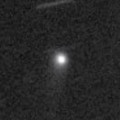
|
Now it is not observable. In the Northern Hemisphere, it will appear in the morning sky in late April. Then it will brighten up to 14 mag from summer to next winter, and it will be observable in excellent condition. In the Southern Hemisphere, it will be observable in the very low sky only from May to June.
Date(TT) R.A. (2000) Decl. Delta r Elong. m1 Best Time(A, h)
Apr. 1 23 46.32 13 9.3 4.528 3.579 16 15.3 4:21 (252, -2)
Apr. 8 23 51.61 14 54.1 4.474 3.550 20 15.3 4:10 (253, 1)
|

|
Now it is 15.6 mag (Mar. 6, Kunihiro Shima). Now it is not observable. But it will appear in the morning sky in June in the Southern Hemisphere, or in July in the Northern Hemisphere. Then it stays observable at 15.5 mag unil the end of 2017.
Date(TT) R.A. (2000) Decl. Delta r Elong. m1 Best Time(A, h)
Apr. 1 1 50.01 1 6.8 6.312 5.367 17 15.3 19:46 ( 96, -7)
Apr. 8 1 56.39 1 34.8 6.356 5.388 13 15.3 19:53 (101,-12)
|
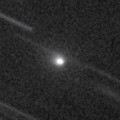
|
Now it is 14.9 mag (Mar. 26, Sandor Szabo). It stays 15 mag until spring. But it is already unobservable in the Southern Hemisphere. It will be getting lower gradually after this also in the Northern Hemisphere.
Date(TT) R.A. (2000) Decl. Delta r Elong. m1 Best Time(A, h)
Apr. 1 2 59.38 26 12.8 2.378 1.729 39 15.4 19:46 (108, 21)
Apr. 8 3 20.78 27 25.0 2.425 1.744 37 15.5 19:53 (111, 20)
|
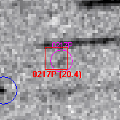
|
It will brighten rapidly, and it is expected to brighten up to 12 mag from July to September. In the Southern Hemisphere, it stays at the same altitude in the morning sky. In the Northern Hemisphere, it will be getting higher slowly.
Date(TT) R.A. (2000) Decl. Delta r Elong. m1 Best Time(A, h)
Apr. 1 21 34.58 -12 44.9 2.268 1.787 49 16.2 4:21 (293, 9)
Apr. 8 21 54.15 -11 39.3 2.169 1.732 51 15.9 4:10 (291, 9)
|

|
Now it is 15.7 mag (Mar. 26, Sandor Szabo). It stays 16-17 mag for a long time from 2016 to 2019. It stays near by the equator.
Date(TT) R.A. (2000) Decl. Delta r Elong. m1 Best Time(A, h)
Apr. 1 9 4.97 5 20.3 8.990 9.599 125 15.9 20:25 ( 0, 60)
Apr. 8 9 4.87 5 37.7 9.080 9.596 118 15.9 19:58 ( 0, 61)
|

|
It brightened up to 11 mag from spring to summer in 2016. It is appearing in the morning sky again. Now it is 16.5 mag (Mar. 4, T. Ikemura, H. Sato). It will be observable at 16-17 mag in good condition from spring to summer.
Date(TT) R.A. (2000) Decl. Delta r Elong. m1 Best Time(A, h)
Apr. 1 20 5.58 -18 25.7 2.892 2.745 71 16.0 4:21 (312, 21)
Apr. 8 20 12.52 -18 4.3 2.838 2.786 76 16.0 4:10 (314, 22)
|

|
Now it is 16.4 mag (Mar. 3, Alexander Baransky). It stays observable at 16 mag until June. It locates low in the Southern Hemisphere.
Date(TT) R.A. (2000) Decl. Delta r Elong. m1 Best Time(A, h)
Apr. 1 6 52.96 27 24.8 3.537 3.685 90 16.1 19:46 ( 75, 69)
Apr. 8 6 57.56 27 16.7 3.633 3.679 84 16.1 19:53 ( 82, 63)
|
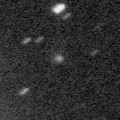
|
Now it is 17.0 mag (Mar. 2, Thomas Lehmann). It is expected to brighten up to 9 mag in summer in 2018. In the Northern Hemisphere, it stays observable until 2018 summer while the comet will be brightening. In the Southern Hemisphere, it is hardly observable in 2017, but it will be observable in good condition in 2018.
Date(TT) R.A. (2000) Decl. Delta r Elong. m1 Best Time(A, h)
Apr. 1 19 12.17 48 49.8 5.579 5.522 81 16.2 4:21 (230, 62)
Apr. 8 19 12.62 49 32.8 5.485 5.466 83 16.1 4:10 (227, 64)
|
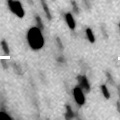
|
Now it is 17.3 mag (Mar. 3, T. Ikemura, H. Sato). It was observed at 16 mag from spring to summer in 2016. It will be observable at 16 mag also in 2017 from winter to spring.
Date(TT) R.A. (2000) Decl. Delta r Elong. m1 Best Time(A, h)
Apr. 1 18 20.63 5 41.9 3.164 3.395 94 16.1 4:21 (322, 55)
Apr. 8 18 23.80 7 45.0 3.105 3.417 99 16.1 4:10 (326, 58)
|

|
It stayed bright 12 mag for a long time from autum in 2015 to summer in 2016. Now it is fading. It has already faded dwon to 16.4 mag (Feb. 15, T. Ikemura, H. Sato).
Date(TT) R.A. (2000) Decl. Delta r Elong. m1 Best Time(A, h)
Apr. 1 17 20.57 -8 24.3 4.210 4.656 110 16.5 4:21 (352, 46)
Apr. 8 17 17.48 -8 48.1 4.154 4.708 117 16.5 4:10 (359, 46)
|
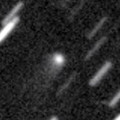
|
Now it is 16.2 mag (Mar. 26, Sandor Szabo). It stays 16 mag for a long time from 2017 to 2018.
Date(TT) R.A. (2000) Decl. Delta r Elong. m1 Best Time(A, h)
Apr. 1 8 22.55 4 24.5 5.117 5.610 114 16.5 19:46 ( 2, 59)
Apr. 8 8 19.87 5 34.4 5.214 5.594 107 16.6 19:53 ( 20, 59)
|

|
Now it is 16.2 mag (Mar. 4, T. Ikemura, H. Sato). It stays 16.5 mag from 2016 to 2017. In the Northern Hemisphere, it stays observable in good condition for a long time. In the Southern Hemisphere, it will never be observable again.
Date(TT) R.A. (2000) Decl. Delta r Elong. m1 Best Time(A, h)
Apr. 1 18 58.14 50 38.0 6.318 6.291 83 16.6 4:21 (225, 63)
Apr. 8 19 0.69 52 8.3 6.299 6.297 85 16.6 4:10 (219, 65)
|
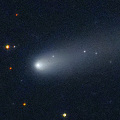
|
It brightened up to 11-12 mag from summer to autumn in last year. Now it is fading. It has already faded down to 14.9 mag (Mar. 3, T. Ikemura, H. Sato).
Date(TT) R.A. (2000) Decl. Delta r Elong. m1 Best Time(A, h)
Apr. 1 11 45.47 -23 13.2 1.640 2.589 156 16.9 23:05 ( 0, 32)
Apr. 8 11 40.20 -21 51.5 1.697 2.635 154 17.1 22:32 ( 0, 33)
|

|
Now it is 17.3 mag (Mar. 6, iTelescope Observatory, Siding Spring). It will brighten up to 15.5 mag in summer. It will be observable in excellent condition in the Southern Hemisphere. It locates somewhat low in the Northern Hemisphere.
Date(TT) R.A. (2000) Decl. Delta r Elong. m1 Best Time(A, h)
Apr. 1 20 27.73 -46 1.0 2.806 2.728 75 17.1 4:21 (327, -4)
Apr. 8 20 42.06 -45 23.8 2.707 2.698 78 17.0 4:10 (326, -3)
|
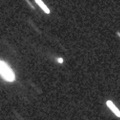
|
Now it is 16.5 mag (Feb. 23, T. Ikemura, H. Sato). It brightened rapidly, and became brighter than originally expected. It stays 17 mag until 2017. In the Northern Hemisphere, it stays observable in excellent condition for a long time. It is not observable in the Southern Hemisphere.
Date(TT) R.A. (2000) Decl. Delta r Elong. m1 Best Time(A, h)
Apr. 1 12 16.79 61 11.6 6.963 7.429 114 17.1 23:36 (180, 64)
Apr. 8 12 6.93 60 48.1 7.019 7.438 111 17.1 22:58 (180, 64)
|

|
It has not been observed since last April. Now it is fading. But it must be bright as 17 mag still now.
Date(TT) R.A. (2000) Decl. Delta r Elong. m1 Best Time(A, h)
Apr. 1 17 10.50 -18 50.7 2.628 3.154 112 17.1 4:21 (356, 36)
Apr. 8 17 9.55 -18 25.8 2.606 3.225 120 17.2 4:05 ( 0, 37)
|

|
It has not been recovered yet in this apparition. It will brighten rapidly, and it is expected to be observable at 15.5 mag in good condition from July to September.
Date(TT) R.A. (2000) Decl. Delta r Elong. m1 Best Time(A, h)
Apr. 1 22 28.05 -27 20.8 3.242 2.635 45 17.3 4:21 (297,-10)
Apr. 8 22 41.45 -26 12.7 3.173 2.620 48 17.1 4:10 (296, -8)
|
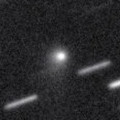
|
It brightened up to 15 mag in early 2016. Now it is fading. It has already faded down to 17.1 mag (Mar. 3, K. Hills). In the Northern Hemisphere, it stays observable in good condition for a long time until autumn when the comet will be fainter than 18 mag. It will never be observable after this in the Southern Hemisphere.
Date(TT) R.A. (2000) Decl. Delta r Elong. m1 Best Time(A, h)
Apr. 1 15 0.55 72 13.2 6.301 6.551 100 17.2 2:23 (180, 53)
Apr. 8 14 49.88 72 15.0 6.352 6.581 98 17.2 1:45 (180, 53)
|
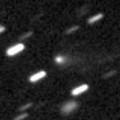
|
Now it is 17.0 mag (Mar. 2, Kunihiro Shima). It is observable in excellent condition in the Northern Hemisphere. It locates low in the Southern Hemisphere.
Date(TT) R.A. (2000) Decl. Delta r Elong. m1 Best Time(A, h)
Apr. 1 6 59.61 31 18.8 3.373 3.545 91 17.2 19:46 ( 84, 72)
Apr. 8 7 5.56 30 51.3 3.484 3.559 86 17.3 19:53 ( 88, 66)
|
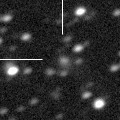
|
Now it is 17.0 mag (Mar. 13, E. Primucci). In the Southern Hemisphere, it is observable at 17 mag in good condition in spring. It stays extremely low in the Northern Hemisphere.
Date(TT) R.A. (2000) Decl. Delta r Elong. m1 Best Time(A, h)
Apr. 1 12 58.47 -45 12.0 5.093 5.884 139 17.2 0:22 ( 0, 10)
Apr. 8 12 54.81 -44 18.6 5.058 5.886 142 17.2 23:47 ( 0, 11)
|
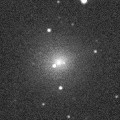
|
It brightened up to 11-12 mag in autumn. Now it is fading. It has already faded down to 16.9 mag (Mar. 3, T. Ikemura, H. Sato).
Date(TT) R.A. (2000) Decl. Delta r Elong. m1 Best Time(A, h)
Apr. 1 13 31.69 -14 35.7 1.611 2.586 163 17.4 0:56 ( 0, 40)
Apr. 8 13 24.96 -13 48.7 1.640 2.635 171 17.6 0:21 ( 0, 41)
|
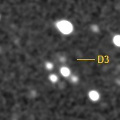
|
Now it is 17.1 mag (Mar. 7, iTelescope Observatory, Siding Spring). It is observable at 17.5 mag in good condition in spring. It locates somewhat low in the Northern Hemisphere.
Date(TT) R.A. (2000) Decl. Delta r Elong. m1 Best Time(A, h)
Apr. 1 12 45.91 -29 24.7 4.047 4.971 155 17.5 0:10 ( 0, 25)
Apr. 8 12 37.64 -27 43.6 4.026 4.970 158 17.5 23:29 ( 0, 27)
|
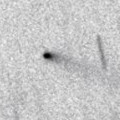
|
Now it is 17.0 mag (Feb. 16, Alexander Baransky). It was observed at 17 mag last winter. It will be observable at 17 mag again next winter. It is observable in good condition in the Northern Hemisphere. But it locates low in the Southern Hemisphere.
Date(TT) R.A. (2000) Decl. Delta r Elong. m1 Best Time(A, h)
Apr. 1 10 58.82 41 53.2 3.584 4.274 128 17.6 22:19 (180, 83)
Apr. 8 10 56.51 42 23.3 3.686 4.305 122 17.7 21:49 (180, 83)
|
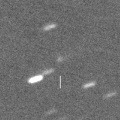
|
Now it is 17.8 mag (Feb. 3, T. Ikemura, H. Sato). It is observable at 17.5 mag in good condition from winter to spring.
Date(TT) R.A. (2000) Decl. Delta r Elong. m1 Best Time(A, h)
Apr. 1 15 8.64 -11 38.4 1.595 2.466 142 17.7 2:32 ( 0, 43)
Apr. 8 15 5.39 -11 32.2 1.566 2.486 150 17.8 2:01 ( 0, 43)
|
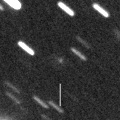
|
It stays at 14 mag for a long time from 2018 to 2019. In the Northern Hemisphere, it stays observable in good condition while the comet will be brightening gradually. In the Southern Hemisphere, it is not observable until 2018 October.
Date(TT) R.A. (2000) Decl. Delta r Elong. m1 Best Time(A, h)
Apr. 1 18 32.34 45 50.9 5.233 5.300 88 17.8 4:21 (232, 69)
Apr. 8 18 30.59 47 37.4 5.137 5.248 90 17.8 4:10 (222, 71)
|
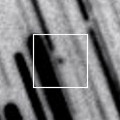
|
It will be observable at 17.5 mag in good condition from April to May.
Date(TT) R.A. (2000) Decl. Delta r Elong. m1 Best Time(A, h)
Apr. 1 18 18.71 -5 41.2 2.066 2.388 96 17.9 4:21 (331, 45)
Apr. 8 18 6.91 -6 48.1 1.939 2.410 105 17.8 4:10 (341, 46)
|
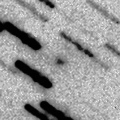
|
Now it is 17.8 mag (Feb. 28, T. Ikemura, H. Sato). In the Northern Hemisphere, it is observable at 17-18 mag until March. It is not observable in the Southern Hemisphere.
Date(TT) R.A. (2000) Decl. Delta r Elong. m1 Best Time(A, h)
Apr. 1 9 41.99 73 23.4 1.856 2.217 97 17.8 21:01 (180, 52)
Apr. 8 9 24.68 68 0.6 1.934 2.261 95 18.0 20:17 (180, 57)
|

|
Now it is 17.9 mag (Mar. 3, T. Ikemura, H. Sato). It stays observable in good condition for a while, but it will be fainter than 18 mag in April.
Date(TT) R.A. (2000) Decl. Delta r Elong. m1 Best Time(A, h)
Apr. 1 12 22.77 5 31.3 1.886 2.873 169 17.8 23:42 ( 0, 60)
Apr. 8 12 17.88 6 12.5 1.935 2.904 161 18.0 23:10 ( 0, 61)
|
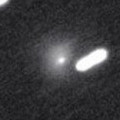
|
Very far object. Outburst occured on Feb. 20, 2015, and it brightened up to 15 mag. Now it is 17.8 mag (June 4, Space Surveillance Telescope, Atom Site). It is observable in excellent condition in the Southern Hemisphere. It locates low in the Northern Hemisphere.
Date(TT) R.A. (2000) Decl. Delta r Elong. m1 Best Time(A, h)
Apr. 1 14 39.81 -26 28.8 8.552 9.380 144 17.9 2:03 ( 0, 28)
Apr. 8 14 38.17 -26 19.7 8.498 9.386 150 17.9 1:34 ( 0, 29)
|
|
![]()
 73P/Schwassmann-Wachmann 3
73P/Schwassmann-Wachmann 3 71P/Clark
71P/Clark 29P/Schwassmann-Wachmann 1
29P/Schwassmann-Wachmann 1 C/2016 R2 ( PanSTARRS )
C/2016 R2 ( PanSTARRS ) 65P/Gunn
65P/Gunn 45P/Honda-Mrkos-Pajdusakova
45P/Honda-Mrkos-Pajdusakova 315P/2013 V6 ( LONEOS )
315P/2013 V6 ( LONEOS ) C/2015 O1 ( PanSTARRS )
C/2015 O1 ( PanSTARRS ) C/2016 VZ18 ( PanSTARRS )
C/2016 VZ18 ( PanSTARRS ) C/2015 VL62 ( Lemmon-Yeung-PanSTARRS )
C/2015 VL62 ( Lemmon-Yeung-PanSTARRS ) 213P/Van Ness
213P/Van Ness C/2016 N4 ( MASTER )
C/2016 N4 ( MASTER ) C/2011 KP36 ( Spacewatch )
C/2011 KP36 ( Spacewatch ) 93P/Lovas 1
93P/Lovas 1 217P/LINEAR
217P/LINEAR C/2014 B1 ( Schwartz )
C/2014 B1 ( Schwartz ) 81P/Wild 2
81P/Wild 2 74P/Smirnova-Chernykh
74P/Smirnova-Chernykh C/2016 M1 ( PanSTARRS )
C/2016 M1 ( PanSTARRS ) C/2016 B1 ( NEOWISE )
C/2016 B1 ( NEOWISE ) C/2014 W2 ( PanSTARRS )
C/2014 W2 ( PanSTARRS ) C/2016 A1 ( PanSTARRS )
C/2016 A1 ( PanSTARRS ) C/2014 OE4 ( PanSTARRS )
C/2014 OE4 ( PanSTARRS ) 43P/Wolf-Harrington
43P/Wolf-Harrington C/2017 D2 ( Barros )
C/2017 D2 ( Barros ) C/2014 R3 ( PanSTARRS )
C/2014 R3 ( PanSTARRS ) C/2015 TQ209 ( LINEAR )
C/2015 TQ209 ( LINEAR ) P/2000 S1 ( Skiff )
P/2000 S1 ( Skiff ) C/2013 V4 ( Catalina )
C/2013 V4 ( Catalina ) P/2015 TP200 ( LINEAR )
P/2015 TP200 ( LINEAR ) C/2017 E3 ( PanSTARRS )
C/2017 E3 ( PanSTARRS ) 144P/Kushida
144P/Kushida C/2017 D3 ( ATLAS )
C/2017 D3 ( ATLAS ) C/2015 X7 ( ATLAS )
C/2015 X7 ( ATLAS ) 94P/Russell 4
94P/Russell 4 C/2016 N6 ( PanSTARRS )
C/2016 N6 ( PanSTARRS ) C/2016 T1 ( Matheny )
C/2016 T1 ( Matheny ) C/2016 T2 ( Matheny )
C/2016 T2 ( Matheny ) 118P/Shoemaker-Levy 4
118P/Shoemaker-Levy 4 C/2013 C2 ( Tenagra )
C/2013 C2 ( Tenagra )![]()










































